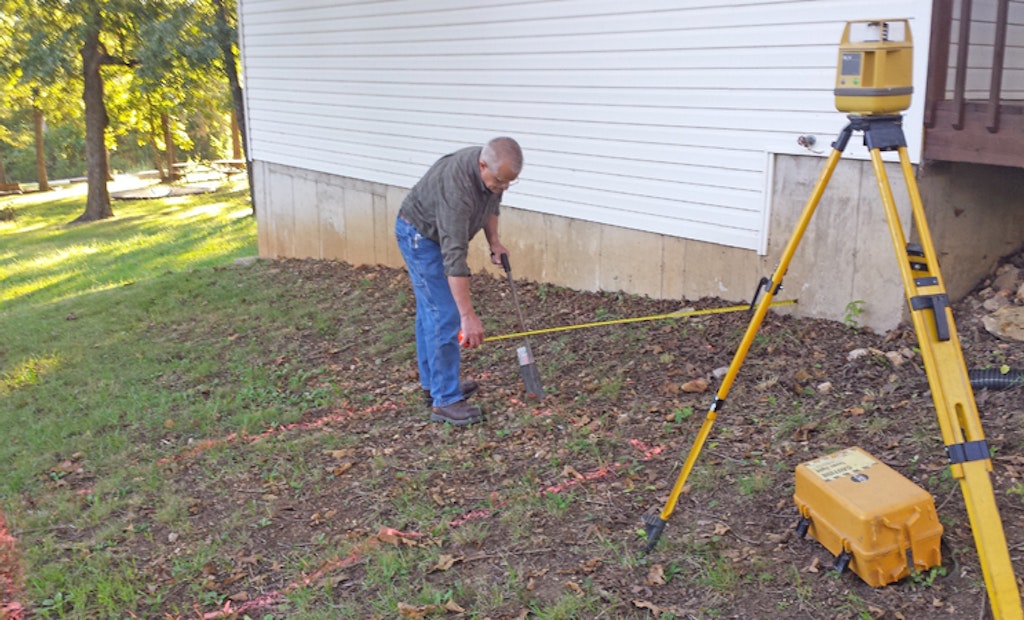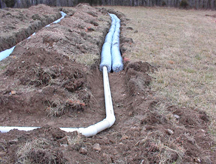How To Calculate Septic Drain Field Size

Interested in Septic Tanks?
Get Septic Tanks manufactures, news and videos right in your inbox! Sign upwardly now.
Septic Tanks + Go Alerts
When you install or repair an existing septic arrangement, the absorption field size should always be i of the more of import blueprint elements. There are many factors involved in sizing an absorption field, including setbacks to wells and property lines, soil and other geological conditions as well as overall site suitability and accessibility.
I'grand going to talk over the factors that make up one's mind the assimilation field size for a conventional septic system. In my state of Missouri, there are minimum statewide regulations sometimes accompanied by additional local regulations.
Keep in listen that regulations in your particular state, county or metropolis may vary from those discussed herein.
Local governing requirements of the procedure
Sizing an absorption field begins with the regulatory guidelines yous are required to adhere to. This may come from land guidelines or a combination of state and county or local guidelines.
The guidelines volition state whether the absorption field be assessed by ways of a percolation test or by a soil evaluation. Some authorities might require both in some instances.
Perc examination factors
Ane factor in determining the size of the absorption field may crave a percolation test. Perc test results are based on how long information technology takes the soil to absorb a specific amount of water in a sample hole bore and depth. These tests are normally used only where there is no significant groundwater contamination potential.
There are very specific conditions and requirements involved in this type of soil analysis. Nearly regulating authorities require simply qualified individuals meeting sure regulatory requirements be immune to perform them.
Soil evaluation factors
A soil evaluation might also be required to calculate the right size of the field. This blazon of soil analysis relates direct to soil permeability and is adamant by a soil morphology evaluation.
Only qualified individuals may perform these types of tests as set forth past the regulating authority. For instance, in southwest Missouri, registered soil scientists perform nearly soil evaluations.
Soil loading rate
Both perc tests and soil evaluations provide data used to determine the soil loading rate. The soil loading rate is the number of gallons per day per foursquare foot the soil will blot.
Once the results of the determined test (percolation, soil evaluation or both) are bachelor, you take the unmarried nigh important gene in the equation of sizing for an absorption field.
Applying the data for correct absorption field size
The regulating government in many areas will base the sizing of absorption fields on a combination of the soil loading rate, the number of bedrooms the system will serve and the number of gallons per bedroom they require to be used in system design.
An instance for a conventional system:
- Number of bedrooms: three
- Soil loading rate: 0.4
- Requirement of gallons used per bedroom: 120
The following formula would be used:
- iii x 120 = 360 gallons per day
- 360 / 0.4 = 900 square feet of conventional trench bottom
- 900 / 2 = 450 lineal feet of ii-foot-wide conventional trenches using 4-inch perforated PVC and gravel
Alternate options for absorption field size
Remember to consider that there are numerous scenarios available in determining absorption field size. For case, your local regulatory authorization might allow an culling assimilation trench media in lieu of 4-inch piping and gravel.
 This alternative media might fit into your 24-inch-broad trench and qualify as the equivalent of a 36-inch-wide trench (varies amid regime), which would reduce the required field to simply 300 lineal feet of trench.
This alternative media might fit into your 24-inch-broad trench and qualify as the equivalent of a 36-inch-wide trench (varies amid regime), which would reduce the required field to simply 300 lineal feet of trench.
Alternately, you could use narrower trenches because of a steep slope and a shallow limiting layer or other factors, in which case, you would need more than lineal feet of trench.
Keep in mind that the figures we have discussed thus far are but for the trenches.
Next, you demand to determine how close to infinite the trenches. The regulating authority will require a minimum spacing distance. That minimum spacing plus some allowance for topography variations along with authentic layout allowances of other organization components (such as the tank and distribution devices) will help you determine how much total surface area you lot need for the absorption field. Don't forget to leave room for pipes from distribution devices to laterals.
The long-term functionality of any septic organisation is determined by multiple factors aside from and including absorption field sizing. Nevertheless, I believe the assimilation field to be of utmost importance.
Call up that the soil assimilation field is where the majority of treatment occurs. Information technology is also the disposal area. Careful consideration and planning in regards to absorption field sizing is the best place to begin system blueprint.
Jon Hancock owns Envirotek Systems in Kimberling City, Mo. He has been providing septic organisation services in Missouri for more than 25 years. Visit him at www.enviroteksystems.com.
How To Calculate Septic Drain Field Size,
Source: https://www.onsiteinstaller.com/online_exclusives/2014/10/your_go_to_guide_for_absorption_field_sizing
Posted by: weaveracrod1984.blogspot.com


0 Response to "How To Calculate Septic Drain Field Size"
Post a Comment